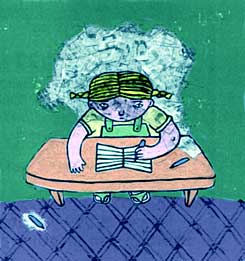It is possible that dyslexia caused by lack of exposure to appropriate stimuli at an early age is even more severe than dyslexia caused by genetic defects
Bonnie Rothman Morris New York Times

Illustration: Orit Arif
Direct link to this page: https://www.hayadan.org.il/dislection1.html
New research reveals that dyslexia is likely caused by two separate types of brain problems. The researchers, from Yale University, used an fMRI (functional magnetic resonance imaging) device to examine the brains of 43 teenagers suffering from reading disabilities while the teens read words presented in front of them. The researchers also tested a group of 27 teenagers who read well. The follow-up of all subjects has been done since they were in elementary school, and the results were published this month in the journal "Psychiatry" Biological.
Among the teenagers suffering from reading disabilities, one group suffers from what the researchers defined as "dyslexia caused mainly by genetic reasons". In these students, disruptions were discovered in the neural pathways in the brain that normal readers use for basic voice and language processing. But the students learned to recruit other parts of the brain to deal with the difficulty. They still read slowly, but are able to understand well what they read.
Teenagers from the second group suffer from a type of dyslexia which, according to the researchers, is "more influenced by the environment". The sound and language processing system in the brains of these students is normal, but it seems that for the purpose of understanding the reading material they rely more on memory than on the language centers of the brain. The reading ability of these students remained low throughout the years of the study and they received poor grades in tests that tested reading speed and reading comprehension.
The students from both groups were from a similar socio-economic background, and at the beginning of their studies at school their reading abilities were similar. However, there were two differences between the groups: first, the students who managed to compensate for their deficiency and improve in reading had higher learning abilities; Second, the students who continued to show low reading ability were twice as likely to study in what the researchers defined as "backward schools".
The lead author of the study, Dr. Sally Shaywitz, said that the researchers were surprised to find that the neural mechanisms related to reading in the brains of the teenagers who suffer from the most severe reading problems - were normal. According to her, this finding implies that the chance of improving the reading abilities of these teenagers is greater than is commonly thought. "In the brains of the students who failed to improve their reading ability, there is a basic neural mechanism that is not damaged, but it is not well connected," said Dr. Shaivitz. "They failed to develop it properly because they were not exposed to appropriate stimuli at an early age."
Many studies have shown that intensive study can correct this type of reading problem, especially if it is started while children's minds are still developing. "If these children receive effective reading instruction at an early stage, they will definitely be able to learn to read," said Dr. Shaivitz.
For the purpose of the study, the participants lay inside an fMRI device and looked through a periscope at one-syllable words that appeared on a computer screen. Their brain activity was mapped while they read.
Students defined as good readers used three areas on the left side of the brain to begin the reading process. The readers who suffered from neural deficits and were able to compensate to some extent even though they still read slowly, did not use the same areas of the brain. Instead, they created alternative neural pathways and used when reading mainly areas on the right side of the brain. According to the researchers, these areas are not suitable for reading.
Paradoxically, the worst readers used the same areas on the left side of the brain that the good readers used to start the reading process. But instead of connecting these areas with other language centers, they activated an area located in the front of the right side of the brain, which is mainly associated with memory.
Overreliance on memory may explain the persistence of students' reading problems. "Once the brain makes the necessary connections for certain tasks, it tends to stick to them," said Dr. Gordon Sherman, director of the Newgrange Center for Education in Princeton, a dyslexia expert who was not involved in the study. "But these links are not necessarily the best."
Learning words based on memorization can advance the student up to a certain limit, but "after that it stops being effective. The student simply has to memorize too many things," said Dr. Sherman.
According to J. Thomas and Eyal, director of the International Dyslexia Association, the results of the study emphasize the need for intensive educational intervention. But Vayel added that more research must be done before it will be possible to translate the findings of the new research into practical applications. "Dyslexia is a disorder whose treatment is education," Vayel said. He said the use of an fMRI device to identify types of dyslexia is "exciting", but added that "unlike devices for measuring blood pressure, there are no fMRI devices in grocery stores".
https://www.hayadan.org.il/BuildaGate4/general2/data_card.php?Cat=~~~585083272~~~174&SiteName=hayadan
